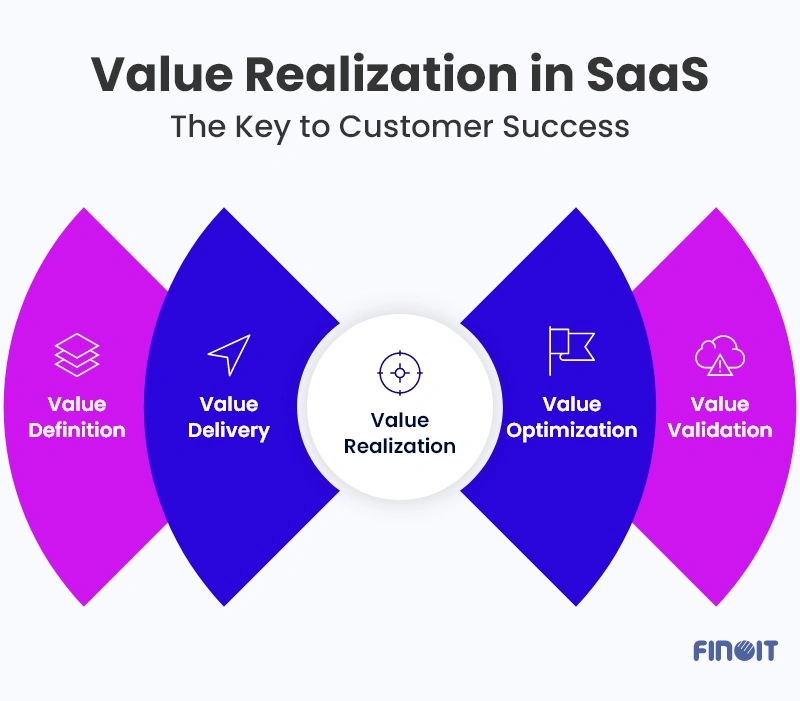Value Realization in SaaS: The Key to Customer Success

Software as a Service (SaaS) has grown exponentially in the enterprise world in the current times . According to studies, the global SaaS market is expected to grow at a CAGR of 18.7%, from $273.55 billion in 2023 to $908.21 billion by 2030. This growth represents a monumental shift in how businesses approach software solutions. However, the question remains whether your enterprise is truly maximizing the potential of its investments. As an entrepreneur, you will always try to grow your business, increase customer success, or acquire new customers. But do you know what is central to your customer success strategy?
In this background, the concept of “Value Realization” gains focus. With businesses investing heavily in SaaS solutions, a clear demonstration of the ROI (Return on Investment) is highly desirable. For the players in the industry, simply adopting the latest technologies is not enough. They must also ensure that the technologies they adopt align with their strategic objectives and deliver measurable value to the stakeholders. In the following part, we will discuss this concept of value realization in the context of a SaaS enterprise and its role in driving customer success.
What does Value Realization mean for your SaaS Enterprise?
Did you know that with a well-crafted customer success program, your business can yield a potential 91% ROI over three years? Customer success rate is one of the priority tasks of those in leadership roles; additionally, they are concerned with their SaaS products’ Return on Investments (ROI). They want to adopt every measure to align their solution with the broader customer objective. In this context, a “Value Realization” strategy is essential. This concept focuses on demonstrating the value of your product or service to customers. Crucial to customer satisfaction, retention, and growth, this strategy empowers C-class executives to understand how to deliver their desired outcomes to customers so that both parties receive maximum ROI.
A higher benchmark of value realization strategy is significant for SaaS companies as it converts users into loyal customers. It ensures customer satisfaction retention and supports your business’s competitive advantage and scalability. Gathering relevant information at different stages, including definition, delivery, realization, validation, and optimization, is imperative to measure value realization. This data should then be used to qualify and quantify the value that customers gain from the product.
Typically, a value realization cycle has five phases, which are as follows:
1.Value definition:
The first phase is where your product or service’s value is first outlined to explain how to build a SaaS product. It is a vital part of sales where expectations are set and outcomes are promised to the customer.
2.Value delivery
In the second phase, your proposed value is delivered to the customer after implementing the product and providing an estimate of the cost to build a SaaS platform. It is an adoption phase, and customers should have access to necessary support and educational content.
3.Value realization
This is the phase when expectations proposed by your business are met and the value proposition promised is delivered. This is a realization stage, where your customers realize they are satisfied with their purchasing decision.
4.Value validation
This is where the customer is sure that the offering they have purchased delivers value and are satisfied with the results. They are open to increasing their usage of the product.
5.Value optimization
This is where customers feel they have got all they can from a product, are primed for upselling or upgrading opportunities, and become brand advocates by spreading the word about your brand or offering.
Metrics to measure the Value Realization of your SaaS Product
Deploying the SaaS software and completing the checklist will not provide an optimum Value realization. Enterprises need to have a comprehensive framework that helps them measure the efficacy and ROI of their SaaS investments. The ultimate goal of every entrepreneur should be to achieve an ideal state where the software becomes a strategic asset rather than just a tool for his customer. This involves continuous planning, measuring, and optimizing software capabilities to ensure they contribute to achieving business goals such as increasing revenue, improving customer satisfaction, or driving operational efficiencies.
However, value realization metrics are highly subjective, unlike other business data analytics. It is crucial to consider the customers’ opinions and sentiments about your product in addition to the quantitative impact your solutions deliver. To improve customer value realization, there are three key performance indicators (KPIs) that you should monitor closely.
1. Return on Investment (ROI)
Return on investment (ROI) is a financial metric that measures the profitability and efficiency of an investment in relation to its cost. ROI refers to the financial gain that a customer anticipates from their investment in a particular product or service.
When evaluating the ROI of a product or service, an enterprise must consider several factors such as the initial cost, the potential revenue or cost savings, and the risk of the investment. Other qualitative aspects, such as the impact on productivity, competitiveness, or customer satisfaction, which are harder to quantify, are also considered by the C-Suite players.
The ROI experienced by the customer is directly proportional to the value they perceive from the investment. When the ROI is high, the product or service is efficient and profitable, which translates into increased value realization for the customer. This, in turn, leads to a greater sense of satisfaction and loyalty towards the product or service.
2. Time to Live (TTL)
The implementation time, also known as Time to Live (TTL), is the duration between signing the contract and deploying your offering. This is distinct from the “time to value (TTV),” which measures the time the customer takes to realize the complete value of your offering, which could take several months or even years. TTL, conversely, signifies the time it takes to initiate and get the offering up and working.
It is a crucial aspect of value realization because it satisfies the customer’s need to feel that they have made the correct decision. If it takes a long time for the solution to start providing the service, customers, your customers may begin to question their purchasing decision, undermining their value realization. Thus, even if an enterprise fulfills every value commitment, slow TTL may dampen its value realization.
3. Time to Value (TTV)
The concept of Time to value (TTV) refers to the duration that a customer takes to fully realize the value of their investment in a product or service. In simple words, if the TTV is shorter, the customer can achieve full value realization sooner. TTV is an essential consideration for C-suite executives who expect to see a considerable raise in their ROI. The quicker the TTV, the faster the customers can enjoy the benefits of their investment and justify the value of their purchase. Several factors could influence the TTV of B2B products and services, including the ease of implementation, the degree of customization required, the necessary training and support, and the complexity of the product or service.
4.Net Promoter Score
The Net Promoter Score (NPS) is a customer loyalty metric that indicates how likely customers are to recommend your product or service to others. The score is calculated by subtracting the percentage of detractors (customers who are not satisfied with your product) from the percentage of promoters (customers who love your product and are willing to recommend it to others). A high NPS score is a good indicator that your customers are satisfied with your product and are willing to spread the word about it to their friends and family. This can lead to increased brand awareness, customer loyalty, and, ultimately, more business. By measuring your NPS score regularly, you can track customer sentiment and improve your product or service to meet their needs and expectations better.
How does Value Realization drives Higher Customer Success Rate?
In a survey when a group of respondents were asked if they were loyal to specific brands or their services, there were three findings:
- More than 50% of the respondents agreed they were loyal to both brands and their services.
- 26% replied that they feel attached to brands, compared to 21% who feel loyal towards products and services.
- In terms of age, Millennials were the group with the highest focus on branding (30%).
These findings point out the cruciality of Value realization plays in driving customer loyalty and retention. A successful customer success strategy is about providing your customers with their desired outcomes to satisfy them with your product or service. Here’s how value realization contributes to enhancing your customer loyalty and ultimately retaining them:
Meeting Customer Expectations:
When customers purchase a product or service, they have certain expectations regarding the value it will provide. Value realization ensures that these expectations are met or exceeded. Customers who realize the value they anticipated has been fulfilled they are more likely to be satisfied and consider their experience successful and will tend to become your loyal customer.
Aligning with Customer Goals:
Building successful customer relationships requires aligning the product or service with the customer’s goals and needs. Value realization helps to understand the customer’s objectives and ensures that the product or service is tailored to help them achieve those goals. Studies show that 89% of companies believe excellent customer service is essential for customer retention.
Providing Incessant Value Delivery:
Customer success is not a one-time event but an ongoing process. Value realization ensures that the customer continues to receive value throughout their engagement with your product or service. This leads to customer satisfaction, ultimately making them loyal to your products or services.
Tracking and Monitoring Customer Outcomes
Value realization involves tracking and monitoring key performance indicators (KPIs) and metrics related to the customer’s usage and outcomes. By doing so, you can identify any potential issues or opportunities for improvement and proactively address them, ensuring that the customer’s experience remains positive.
Proactive Problem Resolution:
If your customers encounter issues or challenges with your product or service, your value realization strategy will encourage a proactive approach to address these problems. Resolving issues promptly demonstrates your commitment to the customer’s success and helps maintain a positive relationship.
Customer Education and Enablement:
Value realization includes educating customers on how to use your product or service effectively. By providing resources, training, and support, you empower customers to derive maximum value from your offering, contributing to their success.
Demonstrating ROI:
Value realization can involve demonstrating the return on investment (ROI) the customer achieves by using your product or service. When customers see that they are getting a tangible return on their investment, they are more likely to view their engagement as successful.
Customer Feedback and Improvement:
Value realization also includes gathering customer feedback to identify areas where improvements can be made. By listening to and acting on customer input, you enhance the value you provide, further contributing to customer success. Improving SaaS customer experience is a continuous process that involves understanding customer needs and making necessary adjustments to meet those needs effectively.
Renewal and Upsell Opportunities:
When customers experience that meeting their needs is pivotal to your value realization and successful outcomes strategy, they are more likely to renew their subscriptions or make additional purchases (upsells). This increases customer lifetime value and signifies a strong customer success story.
Conclusion
“Once you know what you want and what is important for you to achieve, also define the values associated with it. What is important? That is something a lot of entrepreneurs pass by too quickly. For us, the important things were No. 1, customer success. Nothing is more important to us than making sure every customer is successful in our service.”
Says Marc Benioff, Salesforce co-founder, chairman, and co-CEO. As a C-suite leader of a SaaS development company, it is highly agreeable that you will face many challenges while navigating through competitive forces. No matter how small, each decision can significantly impact, and the stakes are now higher than ever before with the evolving customer needs. Therefore, understanding the value of your SaaS solution for your customer is not just an option but a necessity. To ensure customer success, your business must be proactive, agile, and responsive. With experienced customer success resources, you can drive growth with proven processes.
It’s also important to note that the definition and perception of value realization can change over time. Therefore, it’s necessary to define what is perceived as value at frequent intervals. A robust communication with your customers is essential to determine what is valuable to your organization’s value realization.
Setting expectations correctly and managing them will shape customer perceptions and expectations. Proactively creating value for customers without them asking is necessary for any business to succeed. The key is to use the right medium with the right strategies and employ the best communication strategies. This will help create a long-term sustainable strategy for maximizing customer lifetime value and ultimately your customer success rate.
Know how Finoit can help you achieve a higher customer success rate with customized solutions. Request a demo today to know more!


